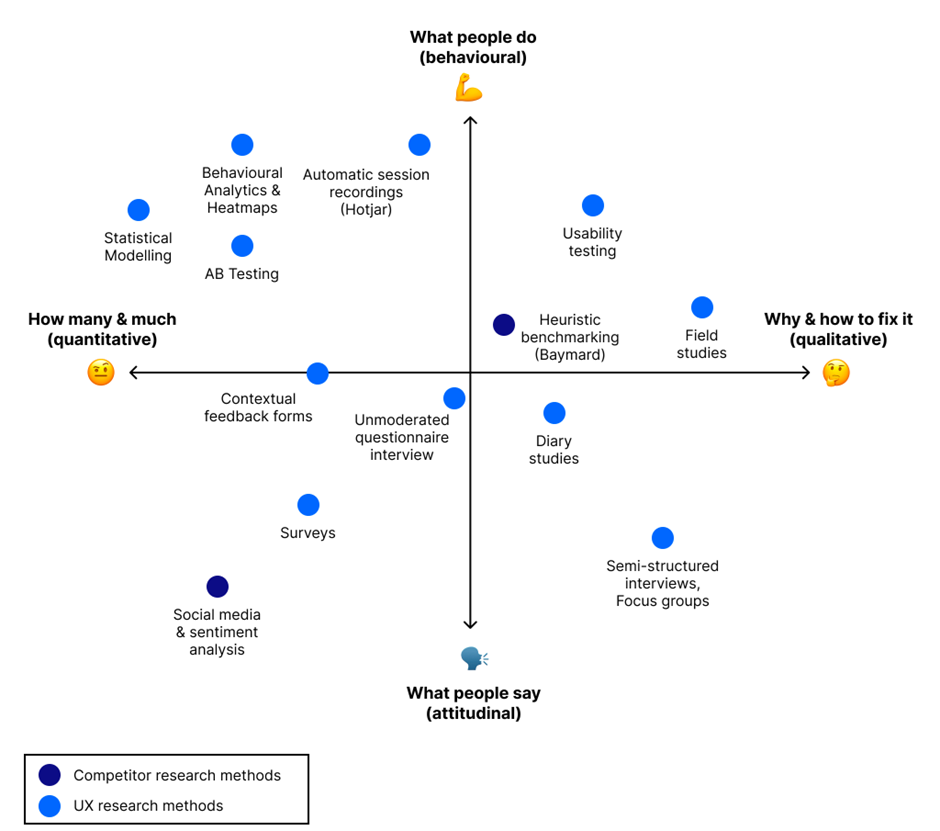E-commerce, Get the Empirical Edge with Vetted Analytics Research
When you buy something online, more often than not, somebody is watching, not over your shoulder but through your device screen. As someone who sits on the other side of the screen and watches such recordings, rest assured that no one is judging your shopping choices. Instead, we are interested in seeing if the website is helping or holding back your shopping experience. There is a team of people who patch together troves of data to try and make sense of the online shopping experience. In fact, these teams are often described as “data-driven.” However, having a team of only data analysis experts can stagnate return on investment when data is narrowly defined and excludes UX research.
UX research is often the data that explains a trend and how it fundamentally works. When working together effectively, a well-formed insights team can provide the business with strategic insights. These include understanding consumer motivation throughout their journey, insights at each stage of the shopping funnel, and identification of consumer disengagement points.
This blog will explain how redefining data and introducing interdisciplinary research in your shop analytics practice can drive value. We will cover:
- Separated expertise, Data and UX
- Interdisciplinary research
- Applying it to e-commerce
Separated expertise, data, and UX
The common analyst team includes roles like data analysts, data scientists, business analysts, perhaps an ML scientist, and a Chief Data Officer (or a similar leading role). This team has the required skills to create insights from available data. However, not all insights are useful for a data-driven decision-making process. If you want actionable data-driven insights, they should be able to demonstrate a pattern and explain why it is happening. The analyst team alone is not best qualified to generate and analyze the type of data needed to understand why a user behaves a certain way. At the same time, that is exactly what an e-commerce conversion funnel analysis aims to achieve. The funnel tracks user behavior to identify drop-offs, customer journeys, and friction points while shopping online.
In a typical analyst team, the human-related expertise is supposed to come from the business analyst. This setup prevents richer data from being generated to make sense of patterns or identify new patterns that a user researcher would offer. Meanwhile, there are UX researchers working in another part of the organization, often in the product team. When these skills are disjointed, organizations miss the big picture in their data because they limit their ability to interpret data7. Some companies try to put a bandage on the problem by setting up communication pathways between the two teams. This may lead to a one-sided relationship, with the data science team sending numbers to product designers without benefiting from the exchange of expertise. To help bridge business and research, some organizations have turned to hiring decision scientists,8 tasked with making research actionable. They, however, cannot fix the issue of low-quality intelligence caused by weak research methods.
E-commerce UX designers and user researchers have valuable skills that are unintentionally siloed from the sales and data analytics teams. These teams seek insights in the treasure trove of data that enterprise organizations collect. UX researchers for e-commerce often conduct AB testing, usability testing, heat mapping, and customer journey mapping but can bring much more to the table. Clever organizations recognize this and leverage UX expertise in behavioral analytics and competitive research, extracting more comprehensive and strategic value from their research investments. Since user researchers are tasked with creating an interaction model with end-users, they can interpret and connect patterns in analytics data efficiently.
Interdisciplinary research
Marrying the skill sets from user research and UX with data science is an ongoing industry discussion.1, 6 It allows researchers to study the social and behavioral rationale, or the why, behind the numbers. This is not a new idea by any means. It comes from a longer sociology discussion about the value of understanding an interaction through a mental model. This understanding is crucial before scaling research on that interaction with quantitative data. Tricia Wang has popularized this discussion as Big and Thick Data4, 5. She describes the ability to understand human interaction through observation and interview as thick data. The ability to scale the understanding through behavioral analytics, surveys, or AB testing is described as collecting the big data. Big data cannot succeed without a fundamental understanding.
Companies have already been bringing these disciplines together for product development. Spotify has built a team and published how they have adapted their approach, ‘simultaneous triangulation,’ to match complementary research methods3. They suggest selecting contrasting study methods based on type that can reveal verified nuanced insights, like comparing results from behavioral analytics to user interviews. Spotify is not the only company successfully bridging data science and UX research. Airbnb and User Testing are also connecting UX research with data science7. All these companies have digital products, so their investments in scaled and vetted insights are highly strategic. E-commerce shops can also benefit from interdisciplinary expertise, especially for global companies.
Applying it to e-commerce
We introduced user research expertise to a data science team for one of our clients seeking to make sense of their e-commerce data. This allowed the team to analyze the conversion funnel across markets in the context of the local user experience. They used a mental model, UX heuristics, and recorded user sessions for the analysis. Instead of a one-sided relationship where the data science team hands the UX team insights, the UX researcher was able to generate hypotheses that would not have otherwise emerged.
Using UX methods and market data analytics, we uncovered and planned a baseline to compare the customer journey across competitors. This allowed us to:
- Bring customer-centric expertise into the analytics process
- Generate new hypotheses for analytics teams to explore
- Breakdown silos between product design, sales, and data analytics
- Create business decisions backed by data
Like other analysts, UX experts can use their knowledge to understand real-world interactions by looking at behavioral analytics, recorded sessions, heatmaps, and conversion funnel analysis. They also generate data through ethnographic studies that challenge or confirm an understanding, produce new findings, or answer the why behind something observed. Popular studies that complement data science methods are user interviews, observational studies, usability testing, and diary studies. Additionally, UX methods like user flow diagramming or customer journey mapping are also useful when making sense of swaths of data. For example, consider your team conducting a conversion funnel analysis across several markets with their local variation. A UX expert would be well suited to determine how the customer journey changes and where data analysts might find insights.

Figure 1: The Landscape of UX research methods for e-commerce
Research methods are organized across a four-quadrant grid based on the method’s ability to scale or understand a problem and if it uses behavioral or attitudinal data. Complementary methods should be selected diagonally. The grid is adapted from the NN Group’s What-Why Framework (9) to highlight UX research methods often used for e-commerce.
During e-commerce engagements, we have found that many brands already collect and report a great deal of data about how their customers move through the purchase funnel, what they purchase, and how they assess the experience. All this data tends to be quantitative, and much of it is behavioral. This data is much more useful for decision-making if balanced with complementary research methods and expertise.
Summing it up
In conclusion, bringing UX expertise closer to data science is essential for optimizing e-commerce strategies. The combined skills strengthen your analysis and allow both teams to make calculated decisions based on customer behavior and motivations backed by well-understood data. This informed decision-making will lead to new ways to engage your customers, higher conversion rates, and improved customer satisfaction. Building interdisciplinary teams that combine data science skills and user research will also improve your data strategy return on investment.
As e-commerce evolves, companies that blend research to create a nuanced view of their customer will stay competitive in a dynamic market. Companies that focus solely on reporting on customer behavior through analytics will struggle to achieve an intuitive and satisfying experience that is adaptive to market trends.
This blog has introduced the value of creating diversity in the data used for decision-making, how it’s done in practice, and which research methods complement behavioral data-rich areas like e-commerce.
References:
- UX and Data Science Teams Need to Work Together, Bahar Salehi, Built In, February 22, 2023: https://builtin.com/design-ux/ux-data-science-work-together
- UX and Data Science Teams Need to Work Together, DataIns Technology LLC, September 26, 2023: https://www.linkedin.com/pulse/ux-data-science-teams-need-work-together-data-ins-technology-llc/
- Simultaneous Triangulation: Mixing User Research & Data Science Methods, Colette Kolenda, Kristie Savage, Spotify Design, July 2019: https://spotify.design/article/simultaneous-triangulation-mixing-user-research-and-data-science-methods
- Big Data Needs Thick Data, Tricia Wang, Ethnography Matters, May 13, 2013: https://ethnographymatters.net/blog/2013/05/13/big-data-needs-thick-data/
- The Cost of Missing Something, Tricia Wang, Tedx Talks, November 28, 2016: The Cost of Missing Something | Tricia Wang | TEDxCambridge
- UX & Data Science should be Best Buddies, Shivangi Singh, Medium, September 22, 2023: https://medium.com/@shivangisingh094/ux-data-science-should-be-best-friends-2c5035e1a7e8
- Why Data Science and UX Research Teams are Better Together, Julie Stanescu, Mind the Product, February 7, 2018:https://www.mindtheproduct.com/data-science-ux-research-teams-better-together/
- How does Decision Science help Data Scientists, Researchers, and Managers?, Santhosh Gandhi, UX Design, February 27, 2022: https://bootcamp.uxdesign.cc/how-does-decision-science-enhance-decision-making-industry-research-69b5120bdcb2
- When to Use Which User-Experience Research Methods, Christian Rohrer, NNGroup, July 17, 2022: https://www.nngroup.com/articles/which-ux-research-methods/
Latest Blogs
he supply chain is a network of suppliers, factories, logistics, warehouses, distributers and…
Introduction What if training powerful AI models didn’t have to be slow, expensive, or data-hungry?…
Pharmaceutical marketing has evolved significantly with digital platforms, but strict regulations…
Leveraging the right cloud technology with appropriate strategies can lead to significant cost…




